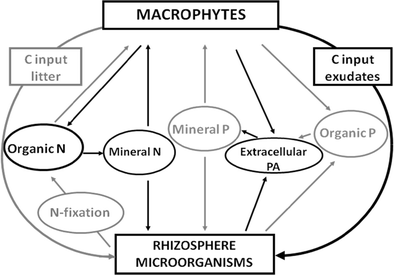 We compared exudation and rhizosphere microbial activity of two macrophytes growing in tropical marshes. Eleocharis spp. are adapted to low nutrient level in phosphorus limited conditions, while sTypha domingensis is a strong competitor in nutrient enriched areas. In situ measurements of carbon fluxes from roots to interstitial water and 13C partitioning after pulse-labelling of the plants in a mesocosm experiment were used to estimate root-derived C fluxes to rhizosphere under P limited and enriched conditions. Root-released compounds collected in the field were analysed for dissolved organic C, dissolved nitrogen and their biodegradability was characterized through microbial respiration, N mineralization and phosphatase activity. Independent of P loading, Eleocharis released more C from roots than T. domingensis, and the released compounds were more biodegradable. The two species responded to P enrichment differently. While Eleocharis invested more assimilated 13C to the belowground (roots, rhizomes and rhizodepositions) after P fertilization, in T. domingensis the belowground investment decreased. The effect of plant species on belowground C allocation was larger than the effect of P enrichment. Low nutrients adapted Eleocharis invested more carbon into exudation and promotion of its rhizosphere microbial community while competitive T. domingensis spent more fixed carbon on its own growth and metabolism.
We compared exudation and rhizosphere microbial activity of two macrophytes growing in tropical marshes. Eleocharis spp. are adapted to low nutrient level in phosphorus limited conditions, while sTypha domingensis is a strong competitor in nutrient enriched areas. In situ measurements of carbon fluxes from roots to interstitial water and 13C partitioning after pulse-labelling of the plants in a mesocosm experiment were used to estimate root-derived C fluxes to rhizosphere under P limited and enriched conditions. Root-released compounds collected in the field were analysed for dissolved organic C, dissolved nitrogen and their biodegradability was characterized through microbial respiration, N mineralization and phosphatase activity. Independent of P loading, Eleocharis released more C from roots than T. domingensis, and the released compounds were more biodegradable. The two species responded to P enrichment differently. While Eleocharis invested more assimilated 13C to the belowground (roots, rhizomes and rhizodepositions) after P fertilization, in T. domingensis the belowground investment decreased. The effect of plant species on belowground C allocation was larger than the effect of P enrichment. Low nutrients adapted Eleocharis invested more carbon into exudation and promotion of its rhizosphere microbial community while competitive T. domingensis spent more fixed carbon on its own growth and metabolism.
Keywords: biological availability, C partitioning, eutrophication, herbaceous marshes, mineralization, P limitation, plant life strategy, rhizodeposition/exudation
